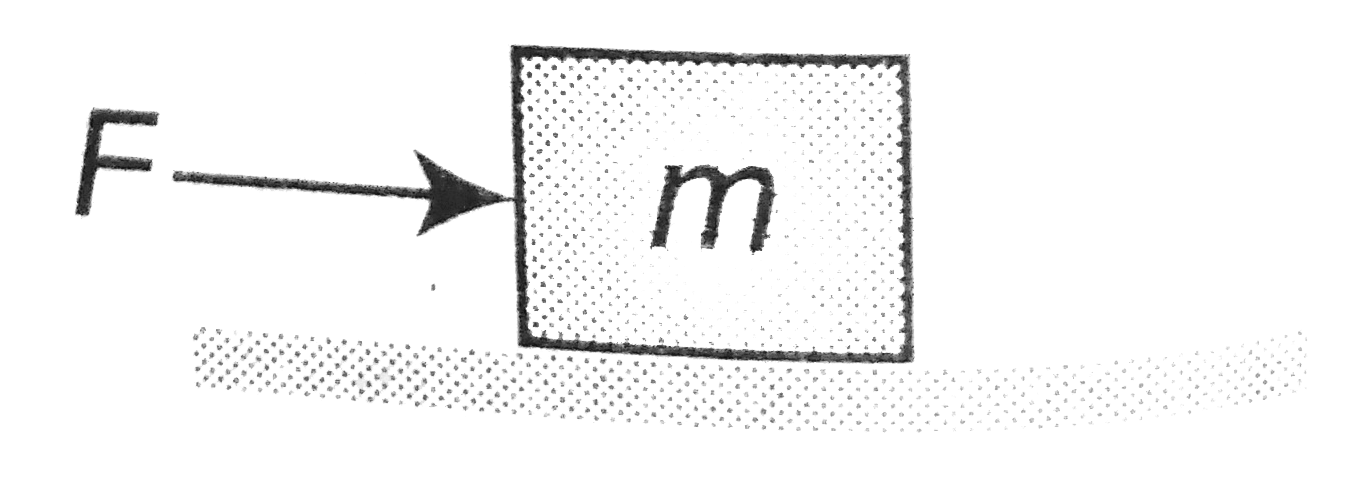If a pushing force making an angle α with horizontal is applied on a block of mass m placed on horizontal table and angle of friction is β, then minimum magnitude of force required to move the block is
mgsinβcos[α−β]
mgsinβcos[α+β]
mgsinβsin[α+β]
mgcosβcos[α−β]
To solve the problem of finding the minimum magnitude of force required to move a block of mass m placed on a horizontal table when a pushing force is applied at an angle α with the horizontal, we can follow these steps:
1. Identify Forces Acting on the Block:
- The weight of the block, W=mg, acts downward.
- The normal force N acts upward.
- The applied force F makes an angle α with the horizontal, which can be resolved into two components:
- Horizontal component: Fcosα
- Vertical component: Fsinα
2. Set Up the Equations:
- In the vertical direction, the forces must balance for the block to be in equilibrium:
N+Fsinα=mg
Rearranging gives:
N=mg−Fsinα(1)
3. Frictional Force:
- The maximum static frictional force fmax can be expressed as:
fmax=μN
- Given that the angle of friction β relates to the coefficient of friction μ as:
μ=tanβ
- Substituting N from equation (1) into the frictional force equation gives:
fmax=tanβ(mg−Fsinα)(2)
4. Horizontal Forces:
- In the horizontal direction, for the block to just start moving, the horizontal component of the applied force must equal the maximum static friction:
Fcosα=fmax
- Substituting equation (2) into this gives:
Fcosα=tanβ(mg−Fsinα)
5. Rearranging the Equation:
- Rearranging the above equation leads to:
Fcosα+Ftanβsinα=tanβmg
- Factoring out F:
F(cosα+tanβsinα)=tanβmg
6. Solving for F:
- Finally, we can solve for F:
F=tanβmgcosα+tanβsinα
7. Substituting tanβ:
- Since tanβ=sinβcosβ, we substitute this into the equation:
F=sinβcosβmgcosα+sinβcosβsinα
- Simplifying gives:
F=mgsinβcosαcosβ+sinβsinα
8. Final Result:
- The final expression for the minimum force required to move the block is:
F=mgsinβcos(α−β)
- The weight of the block, W=mg, acts downward.
- The normal force N acts upward.
- The applied force F makes an angle α with the horizontal, which can be resolved into two components:
- Horizontal component: Fcosα
- Vertical component: Fsinα
- In the vertical direction, the forces must balance for the block to be in equilibrium:
N+Fsinα=mg
Rearranging gives:
N=mg−Fsinα(1)
- The maximum static frictional force fmax can be expressed as:
fmax=μN
- Given that the angle of friction β relates to the coefficient of friction μ as:
μ=tanβ
- Substituting N from equation (1) into the frictional force equation gives:
fmax=tanβ(mg−Fsinα)(2)
- In the horizontal direction, for the block to just start moving, the horizontal component of the applied force must equal the maximum static friction:
Fcosα=fmax
- Substituting equation (2) into this gives:
Fcosα=tanβ(mg−Fsinα)
- Rearranging the above equation leads to:
Fcosα+Ftanβsinα=tanβmg
- Factoring out F:
F(cosα+tanβsinα)=tanβmg
- Finally, we can solve for F:
F=tanβmgcosα+tanβsinα
- Since tanβ=sinβcosβ, we substitute this into the equation:
F=sinβcosβmgcosα+sinβcosβsinα
- Simplifying gives:
F=mgsinβcosαcosβ+sinβsinα
- The final expression for the minimum force required to move the block is:
F=mgsinβcos(α−β)
Topper's Solved these Questions
- LAWS OF MOTIONBOOK - AAKASH INSTITUTECHAPTER - LAWS OF MOTIONEXERCISE - Assignment (SECTION-C)
63 Videos
- LAWS OF MOTIONBOOK - AAKASH INSTITUTECHAPTER - LAWS OF MOTIONEXERCISE - Assignment (SECTION-D) (Assertion-Reason Type Questions)
15 Videos
- LAWS OF MOTIONBOOK - AAKASH INSTITUTECHAPTER - LAWS OF MOTIONEXERCISE - Assignment (SECTION-A)
65 Videos
- KINETIC THEORYBOOK - AAKASH INSTITUTECHAPTER - KINETIC THEORYEXERCISE - EXERCISE (ASSIGNMENT) SECTION - D Assertion - Reason Type Questions
10 Videos
- MAGNETISM AND MATTER BOOK - AAKASH INSTITUTECHAPTER - MAGNETISM AND MATTER EXERCISE - ASSIGNMENT (SECTION D)
26 Videos
Similar Questions
A force F is acting at an angle θ with horizontal on a block of mass 12 kg placed on a rough 3 horizontal surface having coefficient of friction μ=34 as shown in the figure. The minimum value of force F to just move the block will be (g=10ms−2)
View SolutionA block of mass m is kept on a horizontal table. If the static friction coefficient is μ., find the frictional force acting on the block.
View Solution
Knowledge Check
Pushing force making an angle θ to the horizontal is applied on a block of weight W placed on a horizontal table . If the angle of friction is ϕ , magnitude of force required to move the body is equal to :
AWcosϕcos(θ−ϕ)BWsinϕcos(θ+ϕ)CWtanϕsin(θ−ϕ)DWsinθtan(θ−ϕ)Pushing force making an angle θ to the horizontal is applied on a block of weight W placed on a horizontal table . If the angle of friction is ϕ , magnitude of force required to move the body is equal to :
AWcosϕ/cos(θ−ϕ)BWsinϕ/cos(θ+ϕ)CWtanϕ/sin(θ−ϕ)DWsinθ/g tan(θ−ϕ)A pulling force making an angle θ with the horizontal is applied on a block of weight W placed on a horizontal table. If the angle of friction is ϕ, the magnitude of the force required to move the body is equal to
AWCosϕCos(θ−ϕ)BWsinϕCos(θ−ϕ)CWtanϕSin(θ−ϕ)DWSinϕTan(θ−ϕ)
Pulling force making an angle θ to the horizontal is applied on a block of weight W placed on a horizontal table. If the angle of friction is α, then the magnitude of force is α , then the magnitude of force required to move the body is equal to
View SolutionA block is placed on a horizontal table. Identify the force of action
View SolutionA block of mass 10 kg is placed on the rough horizontal surface. A pulling force F is acting on the block which makes an angle θ above the horizontal. If coefficient of friction between block and surface is 43 then minimum value of force required to just move the block is (g=10ms2)
View SolutionA block of mass 2 kg is kept on a rough horizontal floor an pulled with a force F. If the coefficient of friction is 0.5. then the minimum force required to move the block is :-

View SolutionA horizontal force F acts on the block of mass m and the block remains stationary, thr value of friction force is.

View Solution
